Danish
Bergman Bayard M1910 & M1910/21
By:
Cliff Carlisle
Theodor Bergman was
an early designer of auto pistols. His first designs were
from the
1890s. By 1903 he had designed and was having the Bergman
Mars Model
1903 produced in Gaggenau, Germany. The Spanish Army
purchased some
of these in 9mm Largo (Long) (9X23) for service use. In 1907
Bergman
sold the rights to manufacture the M1903 to Anciens Establishments
Pieper
in Belgium. The remainder of the unfilled Spanish contract
went with
the rights to make the pistol. Spain had requested a change
in the
safety of the M1903. This change was incorporated in the
pistols
made by Pieper along with a change from 4 groove rifling to 6 groove
&
the new design was designated the Model 1908.
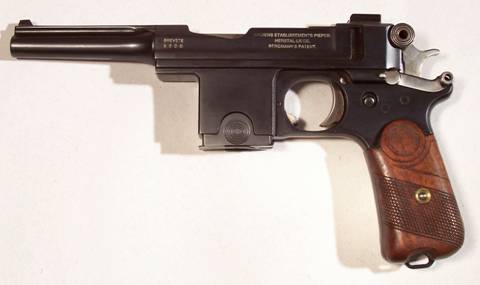
In 1909 Denmark decided
to adopt an auto pistol to replace their Gasser revolvers.
After
a series of tests they adopted the Pieper made M1908 Bergman Bayard in
9X23 as their service pistol. Cut outs had been added to the
magazine
housing to make it easier to remove the magazine & concentric
rings
had been added to the magazine to provide a griping surface to help
remove
it. Denmark designated this pistol the M1910. 4840
M1910 pistols
were delivered by Pieper before the WW1 invasion of Belgium stopped its
production.
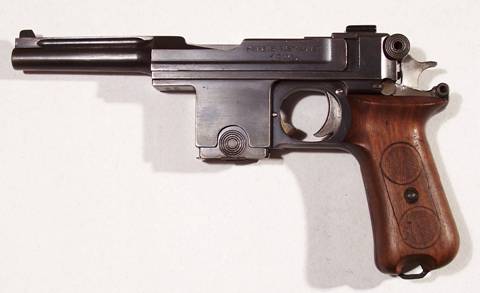
With the M1910 no longer
being produced in Belgium Denmark found it’s self without a source to
buy
its pistols from. Some design changes had been decided upon
by the
Danish military including different grips & the design for the
removal
of the side plate. With these changes incorporated it was
adopted
as the Model 1910/21. In 1922 the manufacture of the new
design was
started in Denmark. From 1922 to 1925 2204 M1910/21 pistols
were
produced at the Danish Army Arsenal in Copenhagen. Pistols
made from
1922 into 1924 were stamped Haerens Tojhus (Army Manufacturing
Arsenal).
Those made later in 1924 & 1925 were stamped Haerens Rustkammer
(Army
Storage Arsenal). During the same period, the M1910 pistols in service
were modified to the M1910/21 configuration and had the new designation
stamped on the left side of the receiver. The grips were
originally
made from Trolite, a plastic material. This material had a
breakage
problem & a large percentage of the pistols were fitted with
wooden
grips.
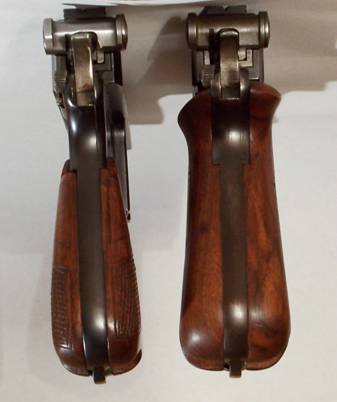
One of the changes
between the M1910 & the M1910/21 was the change from the short,
narrow
grips to tall, wide ones. If you have a large hand the narrow
grip
is difficult to hold & control the pistol during
firing. The
9X23mm Bergman Bayard cartridge is a powerful one. The grip
on the
M1910/21 fills the hand nicely & makes it much easier to fire.
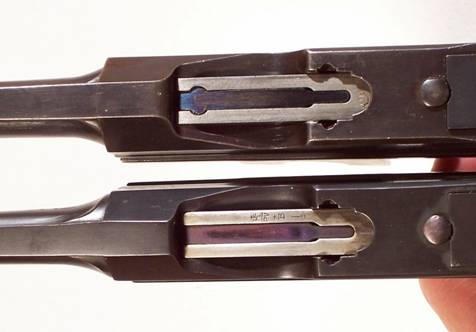
The top pistol is the
M1910/21 while the lower one is the M1910. Note that the
extractor
of the M1910/21 has been modified to strengthen it. The
barrel, just
ahead of the receiver, has been cut back farther. This may
have been
a weight saving change. Note the rectangular locking block at
the
far right in the photo. This block is cammed down to unlock
the bolt
from the receiver as the bolt goes to the rear & up to lock it
again
as the bolt returns to the battery position.
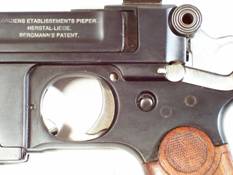
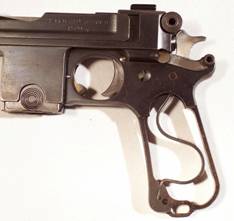
The M1910 on the left
has the button to release the side plate. The M1910/21 on the
right
has the button changed to a special screw. Also note the
unusual
shaped main spring.
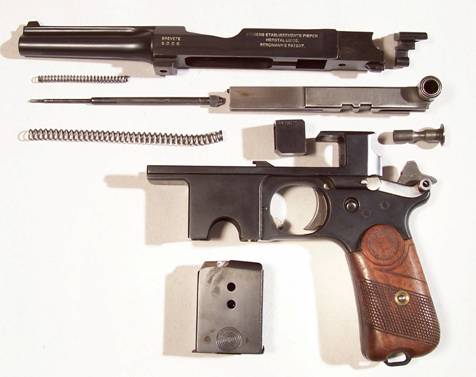
To disassemble either
model follow these instructions. Remove the
magazine. Make
sure that there is no round in the chamber. The right hand
cocking
knob on the bolt has a pin going through it that serves as the firing
pin
retainer. Using a tool, push the firing pin in as
far as it
will go. While holding it in this position, pull the
retaining pin
out of the cocking knob. Release the pressure on the firing
pin &
remove it from the bolt. The rear sight on these pistols is
also
the mainspring retainer. Push the rear sight toward the
muzzle and
carefully lift it up out of the receiver. The recoil spring
will
probably try to come out with the sight. To avoid kinking the
spring,
carefully push it back into the slide. You can re-insert the
firing
pin into its recess & into the spring if needed. This
will straighten
out the spring & allow it to come out with the firing pin when
it is
a removed. The bolt can now be removed to the rear from the
receiver.
Then the receiver can be pulled to the front and off the
frame. The
locking block can then be removed from the receiver. On the
M1910
the side plate can also be removed by pushing on the round button
behind
the trigger. The M1910/21 has a screw in place of the button
&
requires a special tool to remove it.